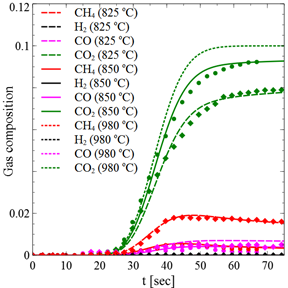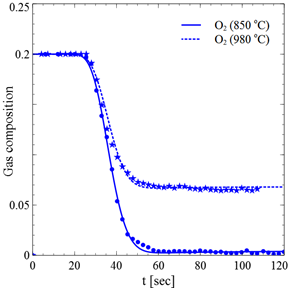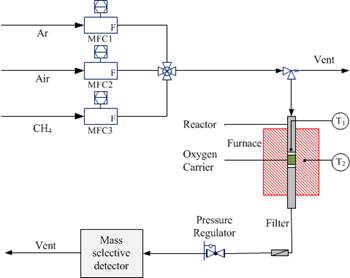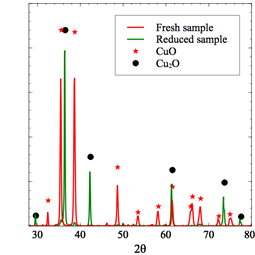

A detailed kinetic network that captures the continuous regime of Cu-based oxygen carrier reactivity in chemical-looping combustion (CLC) and/or chemical-looping with oxygen uncoupling (CLOU) processes is used to study transient and steady state process efficiencies. Theoretical models for CLC/CLOU processes and experimental facilities are utilized for this analysis. The transient kinetics of Cu-based oxygen carriers in the temperature range of 750 to 1000 0C was investigated in a fixed-bed reactor (Figure 1), supported by supplementary characterization techniques, such as TGA, SEM and in-situ hot-stage XRD (Figure 2). The continuous regime between CLC and CLOU, as studied experimentally and theoretically is shown in Figure 3. The effect of operating pressure on the reaction kinetics was also investigated for the purpose of predicting syngas CL processes integrated in IGCC power/hydrogen plants. The established kinetic network is then implemented in different process models to evaluate system performance. The transient behavior of CLC/CLOU is simulated by a hydrodynamic three-phase (bubble, emulsion and wake) model in a fluidized bed reactor, while Aspen Plus process flowsheet simulations are performed to study the steady state behavior. On the basis of the developed Cu-based kinetics and process models, a comprehensive evaluation of the real efficiency of Cu-based CL processes integrated in the power generation infrastructure is carried out.
Acknowledgement: This material is based upon work supported by the National Science Foundation under Grant No. 1054718.
|
|
|
|
Figure 1: Fixed-bed chemical-looping setup used in this work. |
Figure 2: XRD spectra of SiO 2-supported CuO sample in oxidized and reduced (decomposed in Ar) forms.
|


Figure 3: Model prediction and experimental data of (a)chemical-looping combustion selectivity and (b) chemical-looping with oxygen uncoupling using Cu/CuO and CH4/Ar in a fixed-bed reactor. Note: model prediction at 825 0C (dashed line), 850 0C (solid line) and 980 0C (dotted line); experimental data at 825 0C (diamond), 850 0C (circle) and 980 0C (star).


